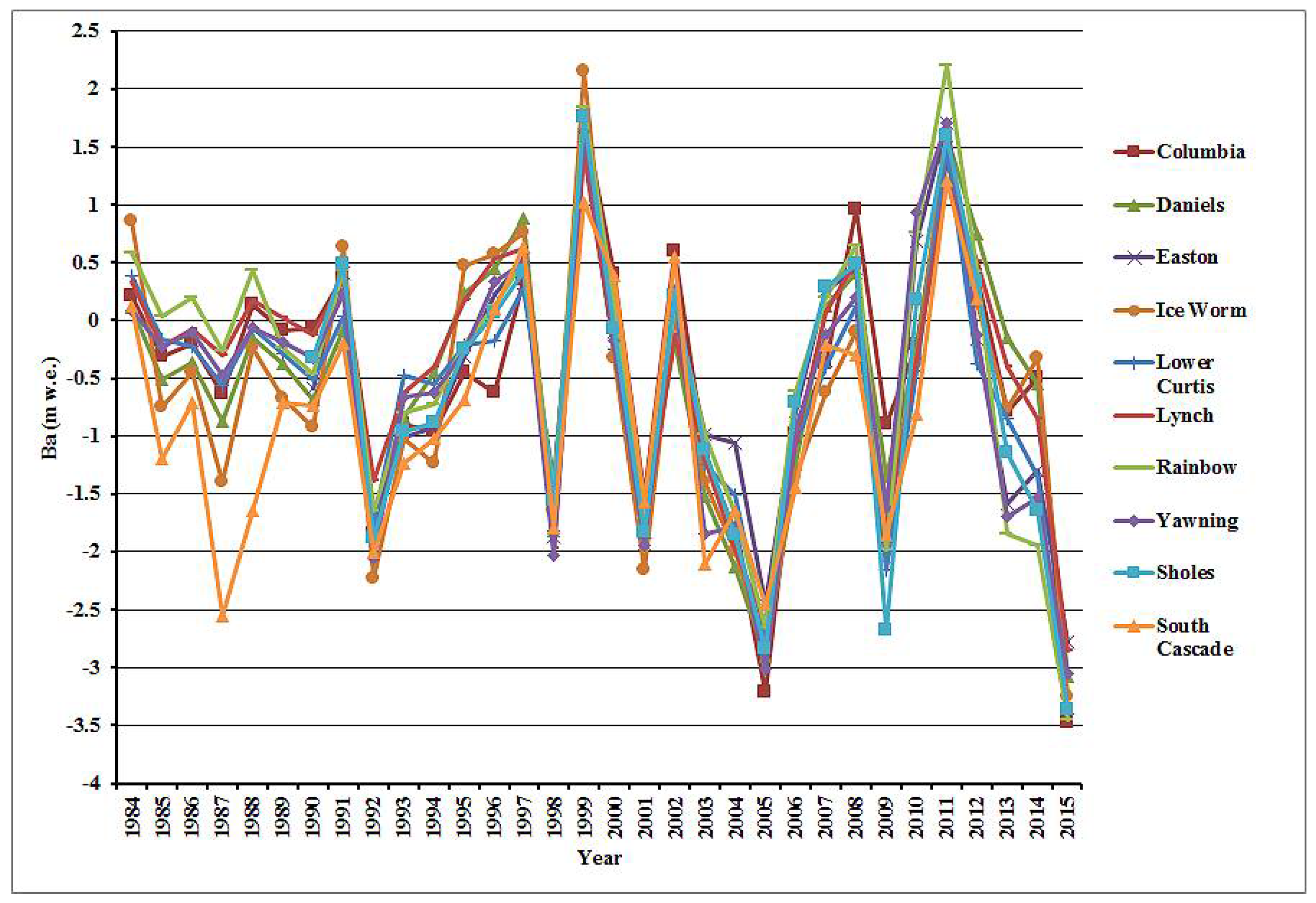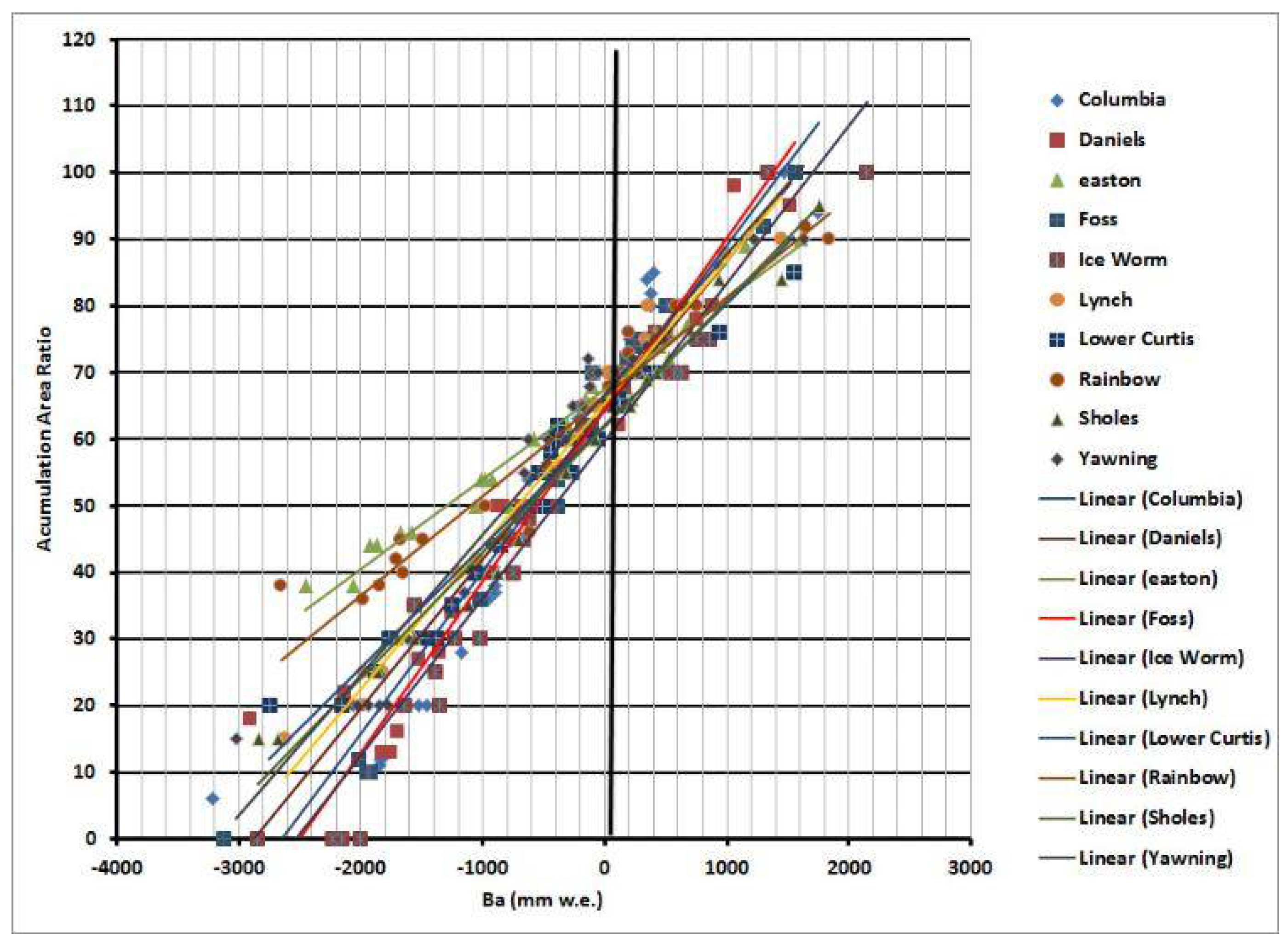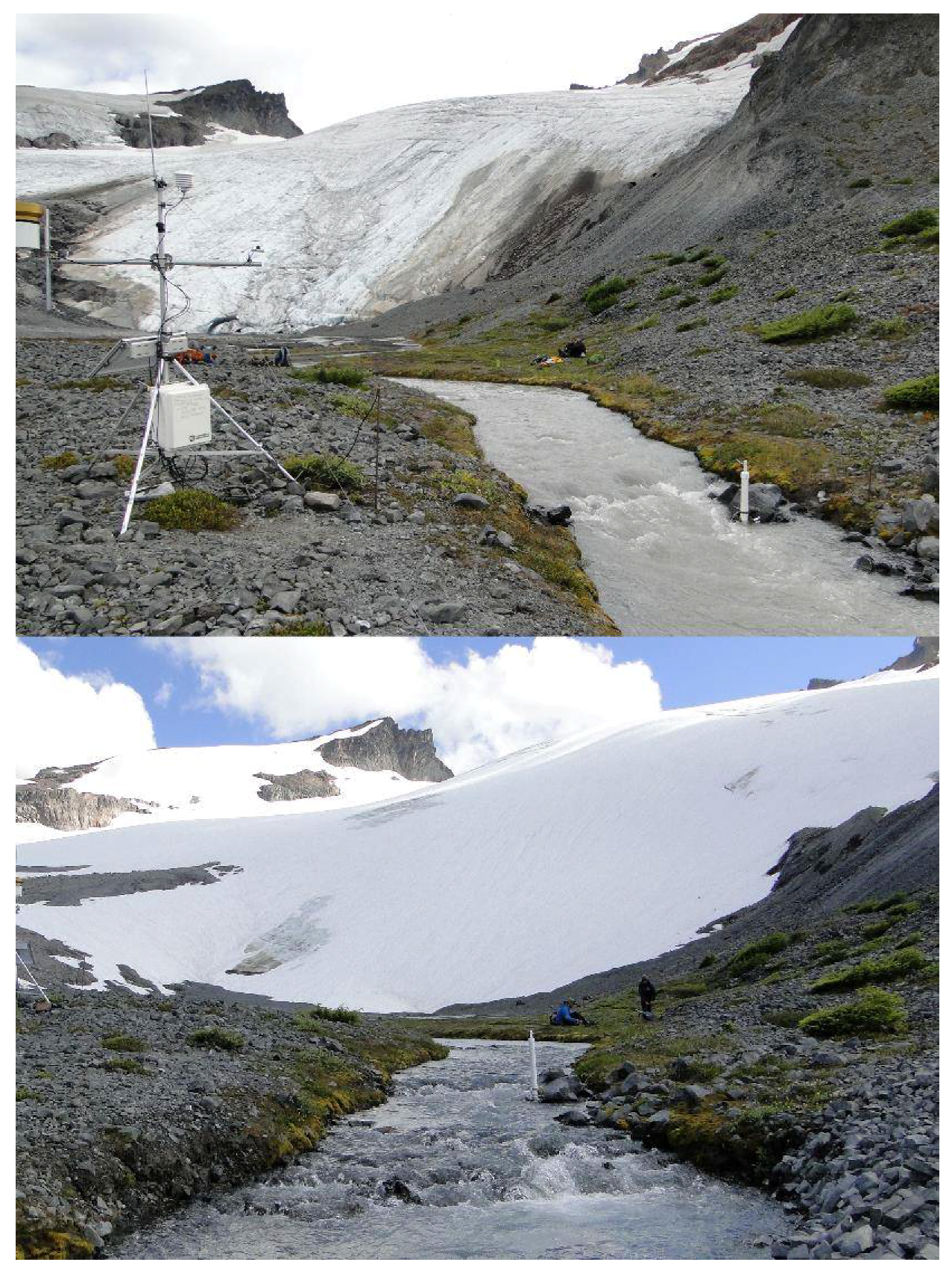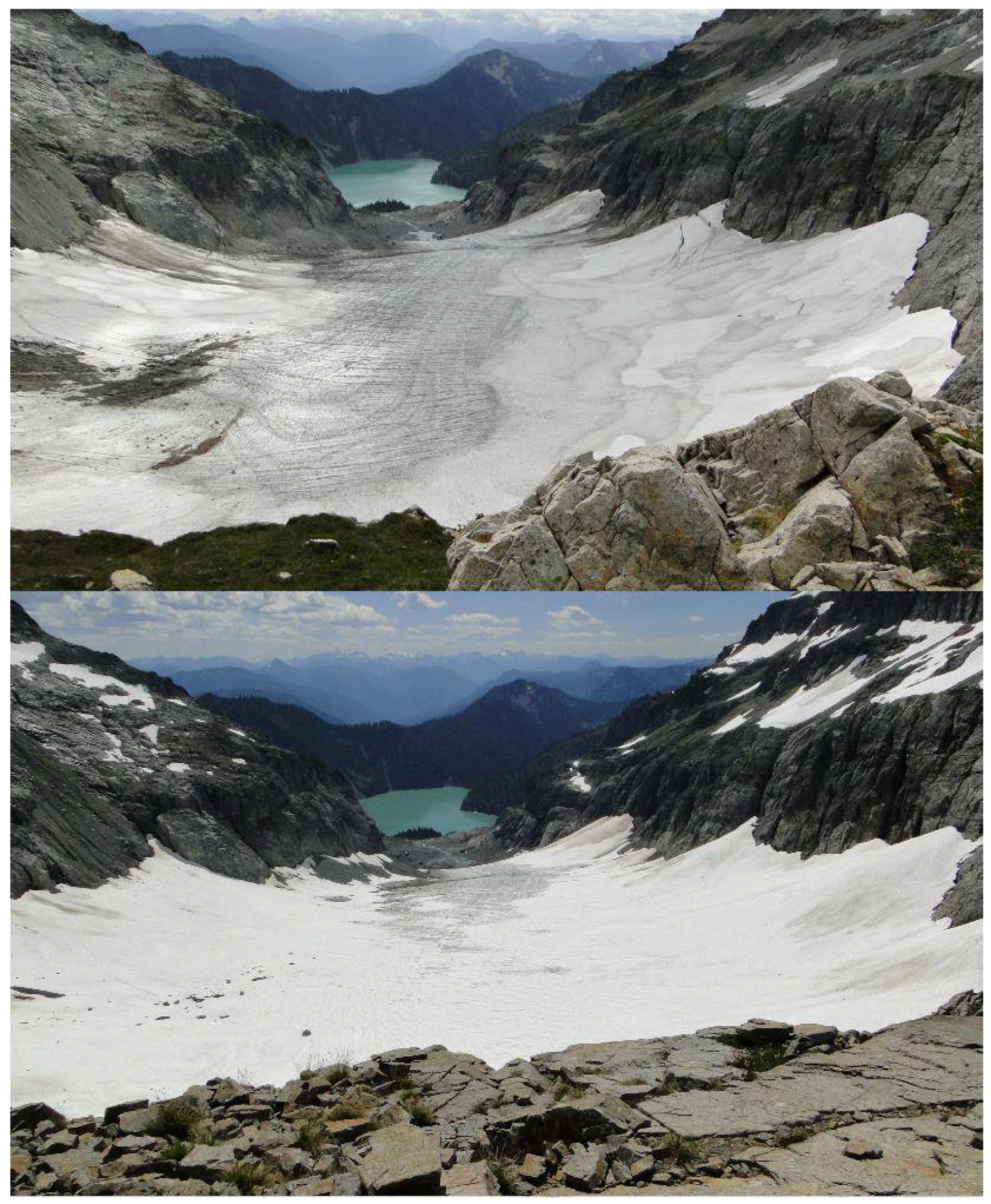How Unusual Was 2015 in the 1984–2015 Period of the North Cascade Glacier Annual Mass Balance?
Abstract
:1. Introduction
2. Methods and Data Sources
2.1. Regional Climate
2.2. Surface Mass Balance
2.3. Accumulation Area Ratio
3. Results
3.1. Annual Mass Balance
3.2. Annual Mass Balance 2015
3.3. Climate in 2015
4. Discussion
5. Conclusions
Acknowledgments
Conflicts of Interest
References
- Bojinski, S.; Verstraete, M.; Peterson, T.; Richter, C.; Simmons, A.; Zemp, M. The concept of Essential Climate Variables in support of climate research, applications, and policy. Bull. Am. Meteorol. Soc. 2014, 95, 1431–1443. [Google Scholar] [CrossRef]
- Zemp, M.; Frey, H.; Gärtner-Roer, I.; Nussbaumer, S.U.; Hoelzle, M.; Paul, F.; Haeberli, W.; Denzinger, F.; Ahlstrøm, A.P.; Anderson, B.; et al. Historically unprecedented global glacier decline in the early 21st century. J. Glaciol. 2015, 61, 745–762. [Google Scholar] [CrossRef]
- WGMS. Global Glacier Change Bulletin No. 1 (2012-2013); Zemp, M., Gärtner-Roer, I., Nussbaumer, S., Hüsler, F., Machguth, H., Mölg, N., Paul, F., Hoelzle, M., Eds.; ICSU(WDS)/IUGG(IACS)/UNEP/UNESCO/WMO, World Glacier Monitoring Service: Zurich, Switzerland, 2015. [Google Scholar]
- Post, A.; Richardson, D.; Tangborn, W.V.; Rosselot, F.L. Inventory of Glaciers in the North Cascades, Washington; US Geological Survey Prof. Paper, 705-A; U.S. Geological Survey: Reston, VI, USA, 1971.
- Granshaw, F.; Fountain, A. Glacier change (1958–1998) in the North Cascades National Park Complex, Washington, USA. J. Glaciol. 2006, 52, 251–256. [Google Scholar] [CrossRef]
- Pelto, M.S. The annual balance of North Cascade, Washington Glaciers measured and predicted using an activity index method. J. Glaciol. 1988, 34, 194–200. [Google Scholar] [CrossRef]
- Pelto, M.; Riedel, J. The spatial and temporal variation of mass balance on North Cascade glaciers. Hydrol. Proc. 2001, 15, 3461–3472. [Google Scholar] [CrossRef]
- Josberger, E.G.; Bidlake, W.R.; March, R.S.; Kennedy, B.W. Glacier mass-balance fluctuations in the Pacific Northwest and Alaska, USA. Ann. Glaciol. 2007, 46, 291–296. [Google Scholar] [CrossRef]
- Fountain, A.; Trabant, D.; Bruggman, M.; Ommaney, C.; Monroe, D. Glacier mass balance standards. EOS 1991, 72, 511–514. [Google Scholar] [CrossRef]
- Abatzoglou, J.T.; Rupp, D.E.; Mote, P.W. Seasonal Climate Variability and Change in the Pacific Northwest of the United States. J. Clim. 2014, 27, 2125–2142. [Google Scholar] [CrossRef]
- Mote, P.; Hamlet, A.; Salathe, E. Has spring snowpack decline in the Washington Cascades? Hydrol. Earth Syst. Sci. 2008, 12, 193–206. [Google Scholar] [CrossRef]
- Abatzoglou, J.T. Influence of the PNA on Declining Mountain Snowpack in the Western United States. Int. J. Climatol. 2011. [Google Scholar] [CrossRef]
- Rasmussen, L.A.; Conway, H.B. Using upper-air conditions to estimate South Cascade Glacier (Washington, U.S.A.) summer balance. J. Glaciol. 2003, 49, 456–462. [Google Scholar] [CrossRef]
- Shea, J.M.; Moore, R.D.; Stahl, K. Derivation of melt factors from glacier mass balance records in western Canada. J. Glaciol. 2009, 55, 123–130. [Google Scholar] [CrossRef]
- Mantua, N.J.; Hare, S.R.; Zhang, Y.; Wallace, J.M.; Francis, R.C. A Pacific interdecadal climate oscillation with impacts on salmon production. Bull. Am. Meteorol. Soc. 1997, 78, 1069–1079. [Google Scholar] [CrossRef]
- Wolter, K.; Timlin, M. El Niño/Southern Oscillation behaviour since 1871 as diagnosed in an extended multivariate ENSO index. Int. J. Climatol. 2011, 31, 1074–1087. [Google Scholar] [CrossRef]
- Bitz, C.M.; Battisti, D.S. Interannual to decadal variability in climate and the glacier mass balance in Washington, Western Canada, and Alaska. J. Clim. 1999, 12, 3181–3196. [Google Scholar] [CrossRef]
- Pelto, M.S. Glacier annual balance measurement, forecasting and climate correlations, North Cascades, Washington 1984–2006. Cryosphere 2008, 2, 13–21. [Google Scholar] [CrossRef]
- Pelto, M.S. Recent changes in glacier and alpine runoff in the North Cascades, Washington. Hydrol. Proc. 1996, 10, 1173–1180. [Google Scholar] [CrossRef]
- Pelto, M.S.; Brown, C. Mass balance loss of Mount Baker, Washington glaciers 1990–2010. Hydrol. Proc. 2012, 26, 2601–2607. [Google Scholar] [CrossRef]
- Pelto, M.S. The impact of sampling density on glacier mass balance determination. Hydrol. Proc. 2000, 14, 3215–3225. [Google Scholar] [CrossRef]
- Fischer, A. Comparison of direct and geodetic mass balances on a multiannual time scale. Cryosphere 2011, 5, 107–124. [Google Scholar] [CrossRef]
- Østrem, G. The transient snowline and glacier mass balance in southern British Columbia and Alberta, Canada. Geogr. Ann. A 1973, 55, 93–106. [Google Scholar] [CrossRef]
- Racoviteanu, A.; Williams, M.; Barry, R. Optical remote sensing of glacier characteristics: A review with focus on the Himalaya. Sensors 2008, 8, 3355–3383. [Google Scholar] [CrossRef] [PubMed]
- Hock, R.; Koostra, D.; Reijmeer, C. Deriving glacier mass balance from accumulation area ratio on Storglaciären, Sweden. In Glacier Mass Balance Changes and Meltwater Discharge; IAHS: Wallingford, UK, 2007; Volume 318, pp. 163–170. [Google Scholar]
- WGMS. Glacier Mass Balance Bulletin No. 9 (2004–2005); Haeberli, W., Hoelzle, M., Zemp, M., Eds.; ICSU(FAGS)/IUGG(IACS)/UNEP/UNESCO/WMO, World Glacier Monitoring Service, University of Zurich: Zurich, Switzerland, 2007. [Google Scholar]
- WGMS. Glacier Mass Balance Bulletin No. 10 (2006–2007); Haeberli, W., Gartner-Roer, I., Hoelzle, M., Paul, F., Zemp, M., Eds.; CSU(FAGS)/IUGG(IACS)/UNEP/UNESCO/WMO, World Glacier Monitoring Service, University of Zurich: Zurich, Switzerland, 2009. [Google Scholar]
- Meier, M.F.; Post, A. Recent variations in mass net budgets of glaciers in western North America. IAHS 1962, 58, 63–77. [Google Scholar]
- Braithwaite, R.J.; Müller, F. On the Parameterization of Glacier Equilibrium Line; IAHS: Wallingford, UK, 1980; Volume 126, pp. 263–271. [Google Scholar]
- Bidlake, W.R.; Josberger, E.G.; Savoca, M.E. Modelled and Measured Glacier Change and Related Glaciological, Hydrological, and Meteorological Conditions at South Cascade Glacier, Washington, Balance and Water Years 2006 and 2007; U.S. Geological Survey Scientific Investigations Report 2010-5143; U.S. Geological Survey: Reston, VI, USA, 2010.
- WGMS. Global Glacier Change Bulletin No. 2 (2014-2015); Zemp, M., Nussbaumer, S.U., Gärtner-Roer, I., Huber, J., Machguth, H., Paul, F., Hoelzle, M., Eds.; ICSU(WDS)/IUGG(IACS)/UNEP/UNESCO/WMO, World Glacier Monitoring Service: Zurich, Switzerland, 2017; p. 244. [Google Scholar]
- Pelto, M.S.; Hedlund, C. The terminus behavior and response time of North Cascade glaciers. J. Glaciol. 2001, 47, 497–506. [Google Scholar] [CrossRef]
- Finn, C.A.; Deszcz-Pan, M.; Bedrosian, P.A. Helicopter electromagnetic data map ice thickness at Mount Adams and Mount Baker, Washington, USA. J. Glaciol. 2012, 58, 1133–1143. [Google Scholar] [CrossRef]
- Bond, N.; Cronin, M.; Freeland, H.; Mantua, N. Causes and impacts of the 2014 warm anomaly in the NE Pacific. Geophys. Res. Lett. 2015, 42, 3414–3420. [Google Scholar] [CrossRef]
- Di Lorenzo, E.; Mantua, N. Multi-year persistence of the 2014/15 North Pacific marine heatwave. Nat. Clim. Chang. 2016. [Google Scholar] [CrossRef]
- Pelto, M.S. Forecasting Temperate Alpine Glacier Survival from Accumulation Zone Observations. Cryosphere 2010, 3, 323–350. [Google Scholar] [CrossRef]
- Stahl, K.; Moore, D. Influence of watershed glacier coverage on summer streamflow in British Columbia, Canada. Water Resour. Res. 2006, 42, W06201. [Google Scholar] [CrossRef]
- Grah, O.; Beaulieu, J. The effect of climate change on glacier ablation and baseflow support in the Nooksack River basin and implications on Pacific salmonid species protection and recovery. Clim. Chang. 2013. [Google Scholar] [CrossRef]
- Pelto, M.S. Climate Driven Retreat of Mount Baker Glaciers and Changing Water Resouorces; Springer Briefs in Climate Studies; Springer: Berlin/Heidelberg, Germany, 2015; ISBN 978-3-319-22605-7. [Google Scholar]





| Glacier | Aspect | Area (km2) | Accumulation | To Divide | Elevation (m) |
|---|---|---|---|---|---|
| Columbia | SSE | 0.9 | AV, DS, WD | 15 km west | 1750–1450 |
| Daniels | E | 0.4 | DS, WD | 1 km east | 2230–1970 |
| Easton | SSE | 2.9 | DS, WD | 75 km west | 2900–1700 |
| Foss | NE | 0.4 | DS, WD | At divide | 2100–1840 |
| Ice Worm | SE | 0.1 | DS, AV, WD | 1 km east | 2100–1900 |
| Lower Curtis | S | 0.8 | AV, DS, WD | 55 km west | 1850–1460 |
| Lynch | N | 0.7 | DS, WD | At divide | 2200–1950 |
| Rainbow | ENE | 1.6 | DS, WD, AV | 70 km west | 2040–1310 |
| Sholes | N | 0.9 | DS, WD | 70 km west | 2070–1630 |
| Yawning | N | 0.2 | DS, WD | At divide | 2100–1880 |
| Year | Columbia | Daniels | Easton | Foss | Ice Worm | Lower Curtis | Lynch | Rainbow | Yawning | Sholes | South Cascade |
|---|---|---|---|---|---|---|---|---|---|---|---|
| 1984 | 0.21 | 0.11 | 0.51 | 0.86 | 0.39 | 0.33 | 0.58 | 0.09 | 0.12 | ||
| 1985 | −0.31 | −0.51 | −0.69 | −0.75 | −0.16 | −0.22 | 0.04 | −0.23 | −1.2 | ||
| 1986 | −0.2 | −0.36 | 0.12 | −0.45 | −0.22 | −0.07 | 0.2 | −0.1 | −0.71 | ||
| 1987 | −0.63 | −0.87 | −0.38 | −1.39 | −0.56 | −0.3 | −0.26 | −0.47 | −2.56 | ||
| 1988 | 0.14 | −0.15 | 0.23 | −0.24 | −0.06 | 0.17 | 0.43 | −0.06 | −1.64 | ||
| 1989 | −0.09 | −0.37 | 0.09 | −0.67 | −0.29 | 0.03 | −0.24 | −0.19 | −0.71 | ||
| 1990 | −0.06 | −0.68 | −0.58 | −0.27 | −0.92 | −0.51 | −0.12 | −0.46 | −0.32 | −0.32 | −0.73 |
| 1991 | 0.38 | −0.07 | 0.41 | 0.3 | 0.63 | 0.04 | 0.36 | 0.44 | 0.23 | 0.48 | −0.2 |
| 1992 | −1.85 | −1.7 | −1.67 | −1.92 | −2.23 | −1.76 | −1.38 | −1.65 | −2.06 | −1.88 | −2.01 |
| 1993 | −0.9 | −0.83 | −1.01 | −0.73 | −1.02 | −0.48 | −0.62 | −0.8 | −0.66 | −0.96 | −1.23 |
| 1994 | −0.96 | −0.45 | −0.92 | −0.68 | −1.23 | −0.55 | −0.4 | −0.72 | −0.62 | −0.88 | −1.02 |
| 1995 | −0.45 | 0.24 | −0.31 | 0.31 | 0.47 | −0.21 | 0.18 | −0.2 | −0.26 | −0.25 | −0.69 |
| 1996 | −0.62 | 0.45 | 0.22 | 0.34 | 0.57 | −0.18 | 0.53 | 0.12 | 0.34 | 0.06 | 0.1 |
| 1997 | 0.35 | 0.88 | 0.53 | 0.5 | 0.76 | 0.27 | 0.62 | 0.51 | 0.5 | 0.42 | 0.63 |
| 1998 | −1.46 | −1.82 | −1.87 | −1.95 | −1.64 | −1.38 | −1.97 | −1.49 | −2.03 | −1.56 | −1.8 |
| 1999 | 1.75 | 1.52 | 1.61 | 1.56 | 2.15 | 1.55 | 1.45 | 1.84 | 1.63 | 1.76 | 1.02 |
| 2000 | 0.4 | −0.25 | −0.1 | −0.1 | −0.33 | −0.25 | −0.24 | 0.15 | −0.18 | −0.08 | 0.38 |
| 2001 | −1.52 | −1.75 | −1.93 | −1.92 | −2.15 | −1.88 | −1.82 | −1.71 | −1.94 | −1.83 | −1.57 |
| 2002 | 0.6 | −0.18 | 0.18 | 0.1 | 0.05 | 0.13 | −0.13 | 0.12 | 0.26 | 0.21 | 0.55 |
| 2003 | −1.17 | −1.52 | −0.98 | −1.35 | −1.4 | −1.25 | −1.2 | −0.98 | −1.85 | −1.12 | −2.1 |
| 2004 | −1.83 | −2.13 | −1.06 | −1.94 | −2 | −1.51 | −1.98 | −1.67 | −1.78 | −1.86 | −1.65 |
| 2005 | −3.21 | −2.9 | −2.45 | −3.12 | −2.85 | −2.75 | −2.62 | −2.65 | −3.02 | −2.84 | −2.45 |
| 2006 | −0.98 | −1.25 | −0.79 | −1.02 | −1.35 | −1.06 | −1.05 | −0.61 | −0.93 | −0.71 | −1.45 |
| 2007 | −0.37 | 0.12 | 0.26 | −0.38 | −0.62 | −0.4 | 0.07 | 0.2 | −0.13 | 0.29 | −0.21 |
| 2008 | 0.96 | 0.41 | 0.45 | 0.18 | −0.1 | 0.12 | 0.51 | 0.65 | 0.2 | 0.48 | −0.3 |
| 2009 | −0.9 | −1.35 | −2.06 | −2.02 | −1.56 | −2.15 | −1.82 | −1.98 | −1.62 | −2.68 | −1.86 |
| 2010 | −0.21 | −0.26 | 0.68 | −0.11 | −0.38 | −0.44 | −0.34 | 0.76 | 0.94 | 0.17 | −0.81 |
| 2011 | 1.47 | 1.06 | 1.15 | 1.3 | 1.34 | 0.94 | 0.98 | 1.64 | 1.22 | 1.45 | 1.21 |
| 2012 | 0.38 | 0.75 | −0.16 | 0.25 | 0.15 | −0.38 | 0.51 | 0.42 | 0.34 | −0.12 | 0.19 |
| 2013 | −0.78 | −0.15 | −1.58 | −0.5 | −0.76 | −0.85 | −0.4 | −1.85 | −1.15 | −1.7 | |
| 2014 | −0.5 | −0.8 | −1.3 | −0.62 | −1.35 | −1.12 | −1.94 | −1.53 | −1.65 | ||
| 2015 | −3.48 | −3.08 | −2.78 | −3.25 | −3.40 | −2.85 | −3.45 | −3.05 | −3.36 | −2.72 | |
| Mean | −0.40 | −0.48 | −0.53 | −0.44 | −0.57 | −0.55 | −0.39 | −0.36 | −0.50 | −0.60 | −0.77 |
| Glacier | Daniels | Easton | Foss | Ice Worm | Lower Curtis | Lynch | Rainbow | Yawning | Sholes | South Cascade |
|---|---|---|---|---|---|---|---|---|---|---|
| Columbia | 0.90 | 0.88 | 0.92 | 0.89 | 0.92 | 0.90 | 0.91 | 0.92 | 0.90 | 0.83 |
| Daniels | 1.00 | 0.87 | 0.95 | 0.94 | 0.91 | 0.97 | 0.88 | 0.93 | 0.88 | 0.86 |
| Easton | 0.87 | 1.00 | 0.92 | 0.90 | 0.93 | 0.90 | 0.98 | 0.95 | 0.98 | 0.89 |
| Foss | 0.95 | 0.92 | 1.00 | 0.94 | 0.97 | 0.98 | 0.93 | 0.95 | 0.94 | 0.82 |
| Ice Worm | 0.94 | 0.90 | 0.94 | 1.00 | 0.93 | 0.92 | 0.89 | 0.91 | 0.91 | 0.87 |
| Lower Curtis | 0.91 | 0.93 | 0.97 | 0.97 | 1.00 | 0.95 | 0.94 | 0.94 | 0.96 | 0.81 |
| Lynch | 0.97 | 0.90 | 0.98 | 0.98 | 0.95 | 1.00 | 0.91 | 0.94 | 0.93 | 0.80 |
| Rainbow | 0.88 | 0.98 | 0.93 | 0.93 | 0.94 | 0.91 | 1.00 | 0.96 | 0.98 | 0.80 |
| Yawning | 0.93 | 0.95 | 0.95 | 0.95 | 0.94 | 0.94 | 0.96 | 1.00 | 0.94 | 0.82 |
| Sholes | 0.88 | 0.98 | 0.94 | 0.91 | 0.96 | 0.93 | 0.98 | 0.94 | 1.00 | 0.91 |
| South Cascade | 0.86 | 0.89 | 0.82 | 0.87 | 0.81 | 0.80 | 0.80 | 0.82 | 0.91 | 1.00 |
| Climate Variable | COL | DAN | EAS | FOS | IW | LC | LY | RBW | YWG | SHS | SC |
|---|---|---|---|---|---|---|---|---|---|---|---|
| Corr-SWE | 0.79 | 0.77 | 0.74 | 0.72 | 0.78 | 0.75 | 0.76 | 0.70 | 0.71 | 0.77 | 0.67 |
| Corr AT | −0.68 | −0.67 | −0.79 | −0.64 | −0.70 | −0.74 | −0.71 | −0.79 | −0.74 | −0.80 | −0.72 |
| Time Period | Winter PPT (November–March) | April 1 SWE | SWE/PPT | Ablation Season Temp. (May–September) | Summer Temp. (June–September) | Freezing Level (November–March) |
|---|---|---|---|---|---|---|
| 2015 | 2.62 | 0.52 | 0.19 | 18.14 | 18.83 | 1644 |
| 1950–2015 | 2.5 | 1.14 | 0.46 | 15.94 | 16.86 | 1077 |
| 1984–2015 | 2.51 | 1.05 | 0.41 | 16.16 | 17.1 | 1144 |
| Ranking | PDO-W | PDO-S | PDO-A | ENSO-W | ENSO-S | ENSO-A | COMB-W | COMB-S | COMB-A |
|---|---|---|---|---|---|---|---|---|---|
| 1 | 2015 | 1997 | 2015 | 1998 | 1987 | 1998 | 1998 | 1997 | 1987 |
| 2 | 1987 | 1987 | 1993 | 1987 | 1997 | 1987 | 1987 | 1993 | 2015 |
| 3 | 2003 | 2015 | 2003 | 1992 | 2015 | 1992 | 2015 | 1987 | 1998 |
| 4 | 1998 | 1992 | 1987 | 1995 | 1992 | 2015 | 2003 | 2015 | 1993 |
| 5 | 1988 | 1995 | 1994 | 1988 | 1993 | 1993 | 1988 | 1992 | 1992 |
© 2018 by the author. Licensee MDPI, Basel, Switzerland. This article is an open access article distributed under the terms and conditions of the Creative Commons Attribution (CC BY) license (http://creativecommons.org/licenses/by/4.0/).
Share and Cite
Pelto, M.S. How Unusual Was 2015 in the 1984–2015 Period of the North Cascade Glacier Annual Mass Balance? Water 2018, 10, 543. https://doi.org/10.3390/w10050543
Pelto MS. How Unusual Was 2015 in the 1984–2015 Period of the North Cascade Glacier Annual Mass Balance? Water. 2018; 10(5):543. https://doi.org/10.3390/w10050543
Chicago/Turabian StylePelto, Mauri S. 2018. "How Unusual Was 2015 in the 1984–2015 Period of the North Cascade Glacier Annual Mass Balance?" Water 10, no. 5: 543. https://doi.org/10.3390/w10050543
APA StylePelto, M. S. (2018). How Unusual Was 2015 in the 1984–2015 Period of the North Cascade Glacier Annual Mass Balance? Water, 10(5), 543. https://doi.org/10.3390/w10050543





